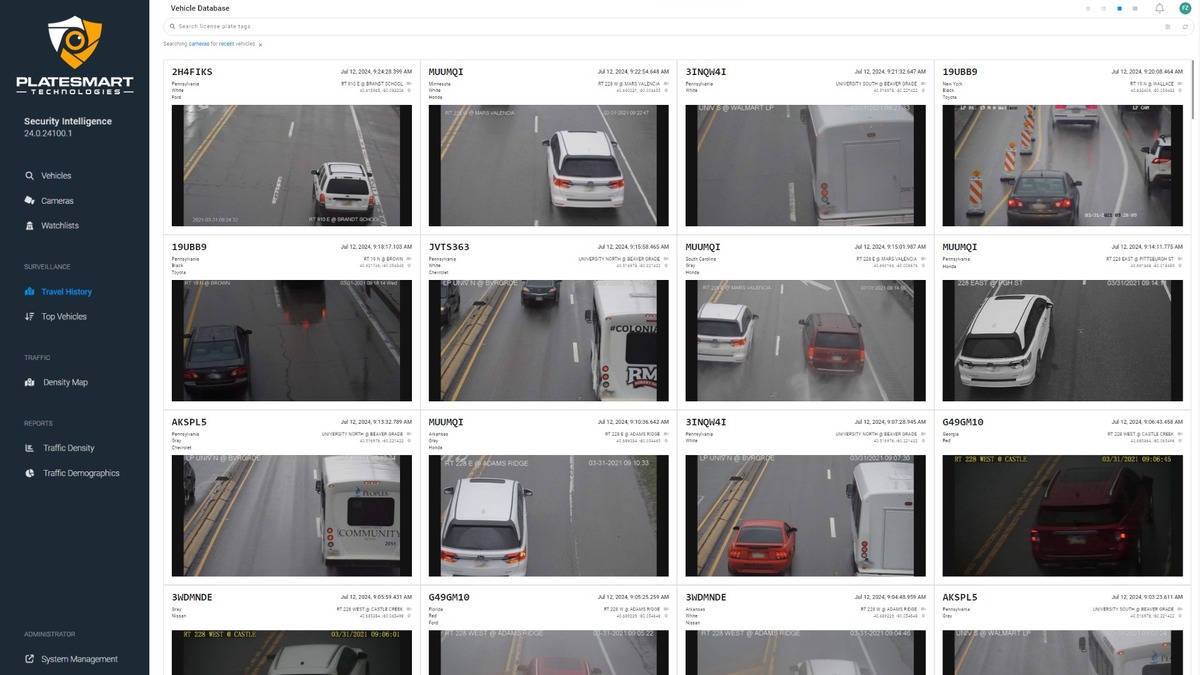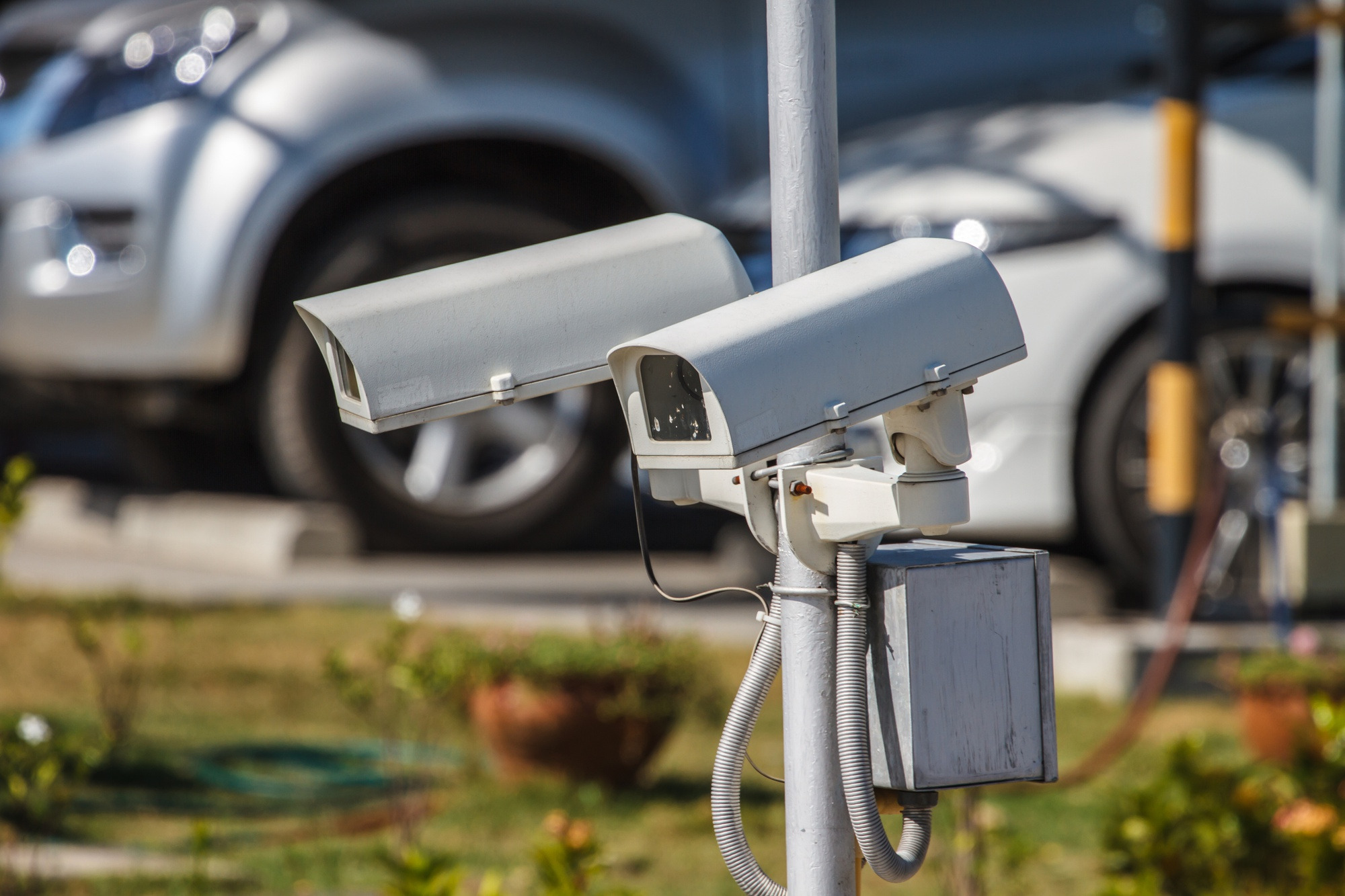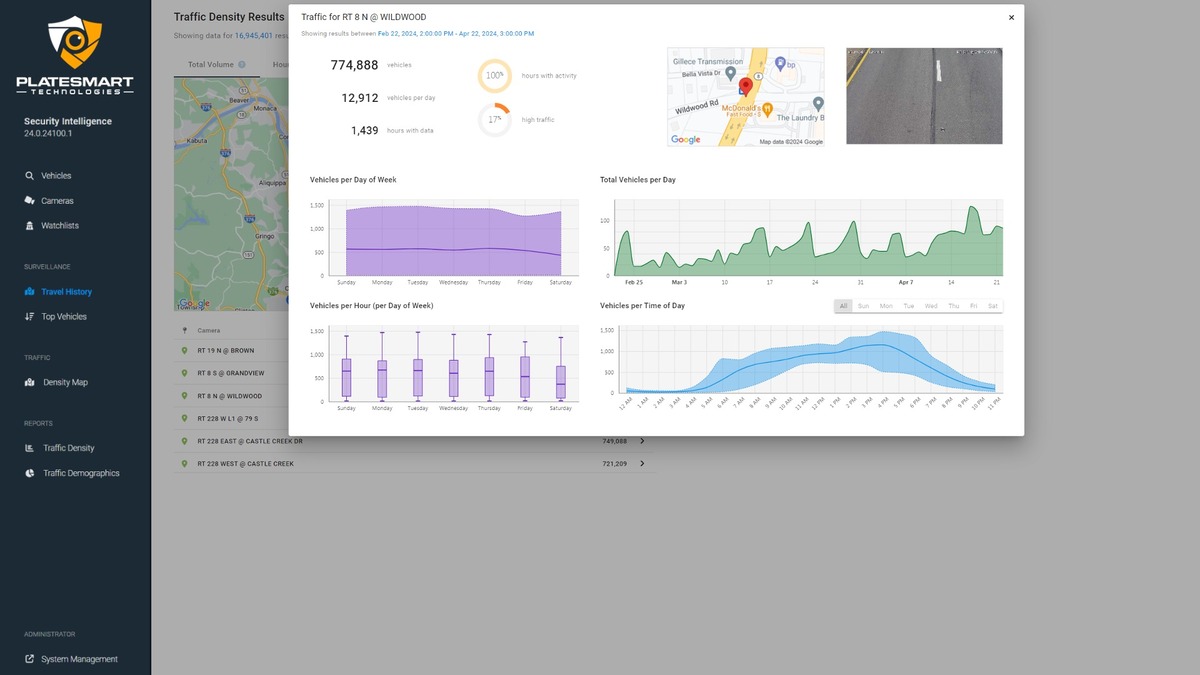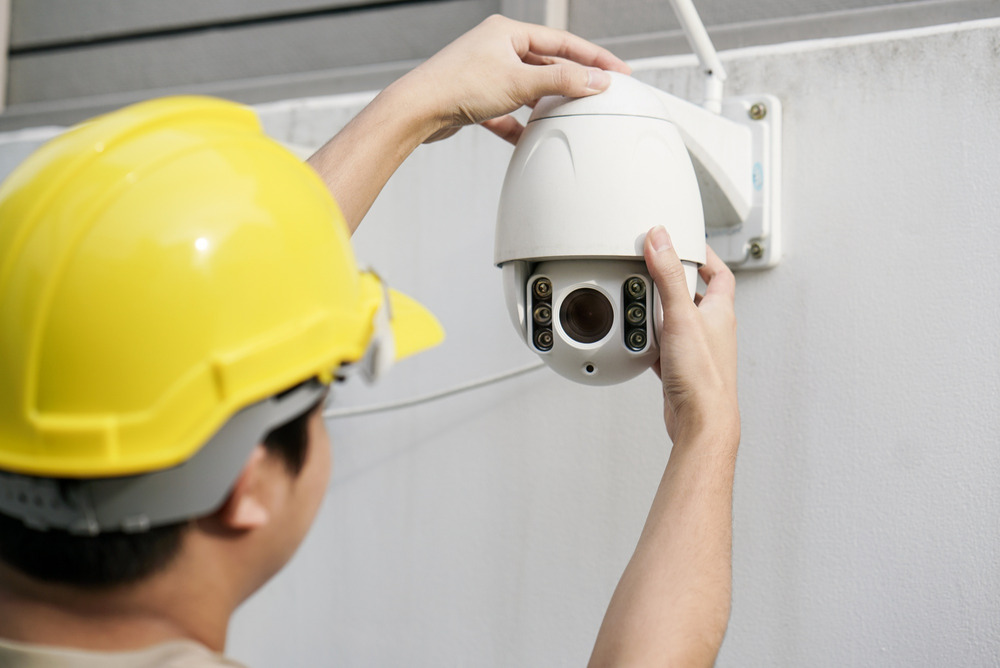Revolutionizing Fleet Management: PlateSmart ALPR Solutions for the Rental Car Industry
Discover how PlateSmart's intelligent ALPR technology revolutionizes rental car fleet management by providing real-time vehicle tracking, reducing turnaround times, and transforming operational inefficiencies into competitive advantages across the industry.

1. The Rental Car Industry Landscape
The rental car industry represents a massive segment of the transportation sector, managing millions of vehicles across thousands of locations worldwide. These operations involve complex logistics where vehicles constantly move between customer return lots, cleaning facilities, maintenance centers, and storage areas—creating significant challenges for fleet visibility and operational efficiency.
Given the extensive vehicular movement involved in rental operations, the obvious solution might be to install trackers in each vehicle for perfect fleet tracking. However, unlike logistics company fleets used exclusively in-house, rental vehicles are driven by customers, making any form of in-vehicle tracking inappropriate and a serious privacy concern.
This privacy constraint makes ALPR technology the perfect solution—monitoring vehicles only at operational checkpoints while respecting customer privacy during rental periods.
Modern rental car companies face intense competitive pressure in an industry where margins are tight and customer expectations continue to rise. The ability to maximize fleet utilization, minimize turnaround times, and maintain operational efficiency directly impacts profitability and customer satisfaction.
Here are some interesting statistics about the rental car industry:*
Market Size:
Fleet and Usage:
Market Characteristics:
2. Fleet Management Challenges in Rental Operations

Rental car companies operate in a unique environment where asset visibility and process efficiency directly impact revenue generation. Unlike other industries, every hour a vehicle sits idle in processing represents lost rental income, making operational efficiency critical to profitability.
The complexity of rental operations creates multiple points where vehicles can become "stuck" in workflows or lost in the system entirely. These challenges are compounded by the scale of operations, with major rental companies managing hundreds of thousands of vehicles across diverse geographic markets.
Common operational challenges include:
- Asset Visibility: Lack of real-time knowledge about vehicle location and movement status across multiple operational areas
- Process Bottlenecks: Extended processing times at various stages that reduce fleet availability for revenue generation
- Asset Loss: Vehicles becoming unaccounted for in the system, representing significant financial exposure
- Unauthorized Usage: Employee misuse of fleet vehicles for personal purposes, increasing costs and liability
- Manual Tracking Dependencies: Resource-intensive processes requiring significant staff time for basic inventory management
- Customer Experience Issues: Vehicle availability problems leading to extended wait times and reservation uncertainties
- Fleet Utilization Inefficiencies: Suboptimal deployment of vehicles across locations and time periods
These challenges become more complex as rental companies expand their operations, add new locations, or integrate acquired businesses with different operational standards.
3. The Vehicle Movement Connection

Every aspect of rental car operations involves vehicle movement, making automatic license plate recognition technology particularly valuable for this industry. From customer returns to maintenance cycles, vehicles follow predictable patterns that can be monitored, analyzed, and optimized through intelligent vehicle identification systems.
What makes ALPR especially effective in rental operations is the controlled environment—companies own the vehicles, control the facilities, and can implement comprehensive monitoring across their operational workflows. This creates opportunities for both security enhancement and operational optimization that aren't available in many other industries.
The constant movement of vehicles between different operational zones creates natural checkpoints where ALPR technology can provide valuable data about process efficiency, asset location, and potential security issues without creating privacy concerns, as mentioned earlier.
4. The PlateSmart Solution for Rental Car Operations

PlateSmart's ALPR technology offers rental car companies a comprehensive approach to fleet management that addresses both operational efficiency and asset security challenges. The solution transforms vehicle movement from an untracked process into a data-rich source of operational intelligence.
The technology works by creating a network of monitoring points throughout rental facilities, capturing vehicle movements, and analyzing patterns to provide actionable insights for fleet managers. This creates multiple layers of operational benefit:
1. Real-Time Fleet Visibility:
2. Automated Workflow Monitoring:
3. Asset Protection and Recovery:
4. Process Optimization Analytics:
5. Customer Experience Enhancement:
6. Cross-Location Intelligence:
7. Integration Capabilities:
8. Scalable Architecture:
Related Reading:
Goal Setting for ALPR Success: Maximize Your Tech Investment ROI
5. Technical Advantages of ALPR for Rental Operations

PlateSmart's ALPR technology provides several technical capabilities that make it particularly effective in rental car environments:
- Advanced Recognition Capabilities: The system reads license plates accurately even in challenging conditions, including dirty plates, various lighting conditions, and different plate formats—common scenarios in rental operations.
- Flexible Deployment Options: Cameras can be strategically positioned at entry and exit points of operational areas, including return lots, cleaning facilities, maintenance centers, and storage areas, creating comprehensive coverage without requiring major infrastructure changes.
- Real-Time Processing: Immediate analysis and alerting capabilities enable rapid response to operational issues or security concerns, preventing small problems from becoming major disruptions.
- Customizable Business Rules: Alert parameters can be tailored to specific operational requirements, such as vehicles exceeding processing time thresholds or unusual movement patterns.
- Robust Data Management: The system maintains comprehensive historical records of vehicle movements, enabling trend analysis, performance measurement, and regulatory compliance reporting.
Looking to elevate your security infrastructure with cutting-edge ALPR?
Call us today at (813) 749-0892 for a free consultation.
6. Expected Benefits of ALPR for Rental Car Companies


Rental car companies implementing PlateSmart's ALPR technology typically experience improvements across multiple operational dimensions:
Enhanced Fleet Utilization:
Operational Efficiency Gains:
Customer Experience Improvements:
Asset Protection and Recovery:
Financial Performance:
ALPR Case Studies
Read these insightful case studies to understand how ALPR acts as a powerful force multiplier to security teams and helps businesses optimize their operations and serve customers better.
7. ALPR Implementation Considerations

For rental car companies, implementing ALPR technology requires careful planning and early goal setting to maximize both operational benefits and return on investment:
- Strategic Camera Placement: Optimal positioning at key operational checkpoints, including customer return areas, cleaning facilities, maintenance centers, and storage lots to ensure comprehensive vehicle tracking coverage.
- Integration with Existing Systems: Seamless connection with current fleet management platforms, maintenance systems, and customer service applications to enhance rather than replace existing investments.
- Scalable Deployment Strategy: Beginning with high-volume locations to demonstrate value before expanding across the entire operation, allowing for learning and optimization during rollout.
- Staff Training and Change Management: Ensuring operational teams understand system capabilities and integrate ALPR data into their daily workflows for maximum benefit realization.
- Performance Measurement Framework: Establishing baseline metrics and ongoing measurement processes to track system effectiveness and identify additional optimization opportunities.
-
Choosing the Right Connectivity Option: Selecting between wired, Wi‑Fi, or cellular connections based on site infrastructure and coverage needs to ensure reliable real‑time data transmission.
8. Industry Applications of ALPR Beyond Basic Tracking

The versatility of PlateSmart's ALPR technology enables rental car companies to address numerous operational scenarios:
Fleet Rebalancing: Analysis of vehicle movement patterns helps optimize the distribution of vehicles between locations based on demand patterns and seasonal variations.
Maintenance Scheduling: Tracking vehicle utilization and movement enables predictive maintenance scheduling and ensures vehicles don't miss required service intervals.
Quality Assurance: Monitoring processing times helps identify when service quality may be declining and enables proactive intervention to maintain standards.
Third-Party Coordination: When working with vendors for vehicle transport or services, ALPR provides verification and tracking of third-party activities on rental company property.
Regulatory Compliance: Comprehensive tracking records support regulatory reporting requirements and provide documentation for insurance and legal purposes.
Business Intelligence: Long-term analysis of vehicle movement data provides insights for strategic decisions about facility expansion, process improvements, and resource allocation.
9. Conclusion: Transforming Fleet Operations Through ALPR-Driven Vehicle Intelligence

The rental car industry's success depends on maximizing asset utilization while minimizing operational friction. PlateSmart's ALPR technology addresses these fundamental requirements by providing the visibility and intelligence needed to optimize fleet operations.
By transforming vehicle movements from untracked events into rich data sources, rental companies can identify inefficiencies, prevent losses, and continuously improve their operations. The result is a more efficient, profitable, and customer-focused business that can adapt quickly to changing market conditions.
For rental car operators seeking a competitive advantage through operational excellence, PlateSmart's ALPR solution provides the foundation for data-driven fleet management that drives both efficiency gains and customer satisfaction improvements.
Rental companies can also refer to PlateSmart’s ALPR Costs Simplified: Your Essential Planning Guide to effectively plan their budgets and understand the full cost considerations for deploying ALPR technology.
Frequently Asked Questions About ALPR in Rental Car Fleet Management
You can drag-and-drop it like any other Beaver Builder module. Then add all your questions wAutomatic License Plate Recognition (ALPR) technology uses advanced artificial intelligence and machine learning algorithms to automatically read and analyze license plates from digital images and video feeds. Modern ALPR systems like PlateSmart leverage AI to improve speed and accuracy while providing advanced analytics capabilities that go beyond basic license plate detection to deliver comprehensive fleet management insights.
ALPR cameras can be strategically positioned at key operational checkpoints throughout rental facilities to track vehicle movements between return lots, cleaning facilities, maintenance centers, and storage areas. The license plate recognition system creates a network of monitoring points that can provide real-time fleet visibility and automated workflow monitoring without requiring expensive in-vehicle tracking devices.
ALPR technology can increase fleet utilization by providing real-time visibility into vehicle location and processing status, potentially reducing turnaround times from return to ready-for-rental status. The automatic license plate reader can identify bottlenecks in cleaning, maintenance, and preparation processes, enabling managers to optimize workflows and get vehicles back into revenue-generating service faster.
Yes, ALPR systems can provide comprehensive asset protection by monitoring all vehicle movements and alerting managers to unusual patterns or unexpected exits from operational areas. The license plate recognition camera network can detect unauthorized employee use of fleet vehicles and enable rapid location and recovery of missing vehicles, potentially reducing losses from theft and misuse.
Good ALPR solutions have the ability to integrate with other business systems seamlessly. PlateSmart ALPR can provide custom integrations to your existing fleet management platforms, maintenance systems, and customer service applications. This integration can enhance current investments rather than replacing them, providing seamless data flow while adding new operational intelligence capabilities.
ALPR can improve customer experience by reducing vehicle processing times, potentially leading to shorter wait times and better vehicle availability for rentals. The LPR system can enable more accurate reservation fulfillment through real-time inventory visibility and streamlined checkout processes, resulting in faster service and improved customer satisfaction.
Many rental car companies track their vehicles using GPS devices, but these are expensive and create privacy concerns as customers naturally do not wish to be tracked during the rental period. ALPR technology addresses these concerns by monitoring vehicles only at operational checkpoints within company-controlled facilities, not during customer rental periods. This approach can provide complete operational visibility while respecting customer privacy.
Rental car companies can typically see ROI through increased revenue from improved fleet availability, reduced operational costs from process automation, and lower asset losses from better security and tracking. The license plate recognition system can be deployed incrementally starting with high-volume locations to demonstrate value quickly, with many companies experiencing measurable improvements in fleet utilization and turnaround times within the first few months of implementation.
Data Sources*
- https://umbrex.com/resources/how-industries-work/travel-hospitality/how-the-car-rental-industry-works/
- https://www.statista.com/outlook/mmo/shared-mobility/car-rentals/united-states
- https://market.us/report/car-rental-market/
- https://www.businesswire.com/news/home/20250523188404/en/U.S.-Car-Rental-Market-Trends-Analysis-Report-2025-2030---EV-Adoption-Accelerates-in-Rental-Fleets-Catering-to-Eco-Conscious-Travelers---ResearchAndMarkets.com
- https://www.grandviewresearch.com/industry-analysis/us-car-rental-market-report
- https://www.ibisworld.com/united-states/employment/car-rental/1363/
- https://www.repairerdrivennews.com/2023/12/26/car-rental-industry-has-second-record-breaking-year-for-revenue/#:~:text=Rental companies purchased 1 million,2021 and 640%2C000 in 2022.
(The visuals on this page are stock images, used for illustrative purposes only)
